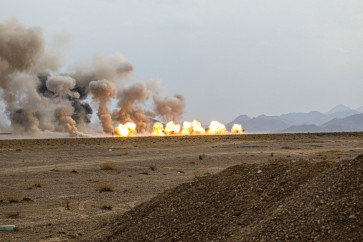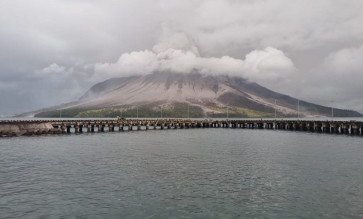Unearthing `peranakan' treasures
"Being peranakan means
Change Size

"Being peranakan means. being a cultural hybrid drawing from and identifying with different racial groups."
The testimonial of Ibrahim Tahir, a Jawi peranakan, is written under the young man's self-portrait displayed on one of the walls at the peranakan Museum in Singapore. The larger-than-life-sized portrait joins dozens of others on the wall, providing a glimpse of what peranakans look like today.
So, who are the peranakans?
Exploring the first floor of the museum gives you a pretty good idea of who they are and how they evolved into an eclectic community that can only be found in Southeast Asia.
Jackie Yoong, the museum's assistant curator insists that while most people mainly associate the peranakan community to Chinese descendants, baba and nyonya, the community actually refers to other cross-cultural groups.
According to her, the term "peranakan", which means "locally born", also encompasses other peranakan sub-communities like the Chitty Melaka (Malaccan Indian Hindus), the Jawi (Indian Muslims) and the Kristang (Eurasian Christians).
Historically speaking, the peranakan community sprouted centuries ago, when foreign merchants and travelers came to Southeast Asia.
While many of the male foreigners returned to their homelands, some remained behind, married local women and started families with them, thus gave birth to the peranakan community. Its culture has evolved over centuries into a unique blend of customs and traditions with traces of Portuguese, Dutch, British, Malay, Indonesian and Chinese influences.
This boutique museum allows visitors to experience the unique peranakan cultures, especially the peranakan Chinese, whose traditions are still part of Singapore's living heritage today.
The Singapore's peranakan Chinese are descendants of Chinese traders who settled in Malacca and around the coastal areas of Java and Sumatra, as early as the 14th century. Drawn by commerce, the peranakan Chinese migrated to the bustling ports of Penang in Malaysia and Singapore in the 19th century.
Showcasing the peranakan fascinating cultures, the museum that was first opened in April 2008 is the first in the world to explore peranakan cultures in the former Straits Settlements of Singapore, Malacca and Penang and their links with other peranakan communities in Southeast Asia, including Indonesia.
It boasts the world's finest collections of peranakan artifacts, presenting a pan Southeast-Asian perspective of the world of peranakans that covers their unique history, colorful fashion, distinctive traditions and cuisine.
All of those colorful historical pieces are displayed in the museum's 10 permanent galleries under several main themes of peranakan life. Remember the story of the peranakan's origin mentioned earlier? It can be found at the museum's first gallery located on the first floor.
Meanwhile, on the second floor, four other galleries explore the theme of the 12-day peranakan wedding, with its characteristic lap chai (exchange of gifts) and chiu thau (coming of age) ceremonies, as well as the wedding procession. One of the many breathtaking artifacts is a stunning ranjan kahwain (wedding bed) that once belonged to Mrs. Quah Hong Chiam of Penang. It was on this bed she gave birth to the first seven of her 11 children.
According to Yoong, in the peranakan tradition, wedding beds were ornately carved and often lavishly decorated with beadwork and embroidery featuring motifs of birds, flowers, rodents, insects and sea creatures - all fertility symbols associated with the peranakan Chinese wedding.
As the story goes, before a wedding, a young boy from a family with many sons would be asked to roll across the bed four times. It was believed that this way, the boy's "male energy" would increase the new bride's chances of having baby boys.
So, as the bride finally becomes a mother, visitors heading to the third floor can watch her daily life unravel in the sixth gallery under the theme of "Nonya" (Nyonya, or foreign married Madam), as well as admire beautiful and colorful ancient textile arts like beadwork and the nonya's traditional costume of kebaya and sarong.
Well-known for their skillfulness in embroidery and beadwork, nyonyas had to devote long hours to perfecting their needlework techniques at their early age. Why? Because a nonya bride was often judged by her needlework before she was fully accepted into her new family.
Besides the beadwork lies the famous sarong and kebaya, which remain the attire of today's nonya. According to Yoong, the kebaya and sarong are the result of a blend of various cultural influences.
While some batik sarong, for example, come from Pekalongan of Indonesia, some kebaya bear the embroideries of camellia, dahlia, violet, tea rose, morning glory and forget-me-not - flowers that are adopted from English pattern books. These kebaya will remind us of the famous "kebaya encim", developed by the Chinese peranakan in Indonesia.
After basking in these visually pleasing rooms, visitors can move to the other sections of this floor, and find the seventh and eight gallery under the theme of "Religion" and "Public life".
While the public life gallery explores peranakan commerce, politics and social affairs, the religious gallery sheds light on how the peranakans embraced a mixture of religious beliefs. Once followers of Taoism and Buddhism, some peranakan families later converted to Catholicism after they interacted with the British colonial rulers.
One exquisite artifact in this gallery is an ancient Catholic altar made of teak. According to Yoong, the once-Taoist altar originally belonged to a peranakan Chinese family, who turned it into a Catholic altar after converting to Catholicism, replacing the Taoist gods with an image of the Holy Family. A New Testament in Baba Malay language that was published in 1913 can also be found in this gallery.
The visual feast continues in the ninth gallery, on the same floor, with colorful foods typical of the peranakan culture.
Ever heard of kamcheng? It's the most recognized form of nonya-ware, a covered container used for storing food, drinking water and desserts. Big kamcheng were very rare and only the wealthiest peranakan families could afford them. Other nonya-ware utensils famous for their vivid enameled tints on a brilliantly colored background, with auspicious phoenix and peony motifs fill the room with bright colors.
So, once the many rooms filled with treasured antiques of the peranakans have been explored, it is time to get a taste of contemporary peranakan culture in the last gallery under the theme of conversations. The gallery unearths how today's peranakans feel about their heritage and the future of their culture, amid an array of contemporary paintings made by a peranakan.
Apart from the 10 permanent galleries, the peranakan Museum also has two other galleries devoted to special exhibitions with different themes each year. Currently, an exhibition titled "Baba Bling: The peranakans and Their Jewellery" features more than 300 pieces of the finest peranakan jewellery that belong to the museum, local and overseas peranakan families, as well as private collectors.
According to Yoong, the museum has been working very closely with local and regional peranakan communities, as well as interest groups, to get an authentic representation of the peranakan way of life - past and present.
The museum, she says, is keen to get in touch with peranakan families from Indonesia who are willing to share their treasured collections. Indonesian peranakan tycoon, Oei Tiong Ham, is said to have played a key role in setting up the old Tao Nan School - the building that is used today for the peranakan Museum.
Peranakan Museum
39 Armenian St. Singapore 179941
Tel: (+65) 6332 7951
Website: www.peranakanmuseum.sg









